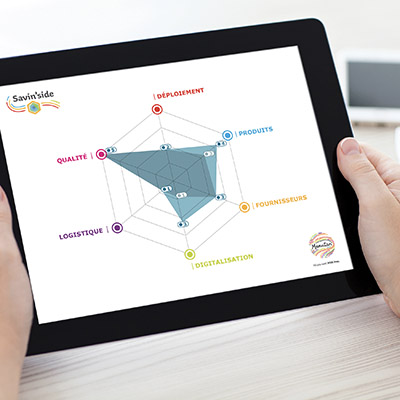For procurement departments, distinguishing KPIs, or key performance indicators, from "simple" metrics, is a source of efficiency. A small number of KPIs, related to the company's strategic targets, are invariably chosen to steer the procurement team towards impactful actions.
However, procurement departments often don't understand the underlying logic behind the KPIs. This is why it's worth taking the time to get to grips with this logic in three steps:
- Understand the difference between metrics and KPIs
- Start with a roadmap to identify key targets
- Draw on clear examples to create relevant KPIs
KPIs: Much more than a metric
Today, procurement departments have digital solutions to collect and process an ever-increasing amount of data. This smart data, which is recorded over time, makes up what are known as metrics.
These metrics are valuable as they can be used to measure objective situations, such as the number of suppliers or the volume of purchases by category. However, these metrics are not key performance indicators. Ce ne sont pas des KPI.
In effect, metrics measure progress without evaluating it. Without being linked to a target, it is impossible to conclude whether they are beneficial for or detrimental to the company. These metrics require a reference point to a strategic aim. They need to be contextualised.
A KPI on the other hand is an indicator that measures progress in relation to a given target. It provides information about how performance is progressing, not just a raw result.
KPIs: It all starts with a roadmap
Imagine that the company is facing a price war in its market and needs to restrict its cost prices as much as possible. In this scenario, a key target would likely be assigned to the procurement department in order to reduce costs.
One well-known way of reducing costs is to group purchases together, so we can assume that reducing the number of suppliers would be a lever the procurement team would implement. For this reason, the number of suppliers would be a KPI, because its decrease would be an indicator of the procurement department's performance.
Now imagine that the company's strategy is to reduce risk. Alarmed by pressure on the supply chain caused by the pandemic, the procurement department would clearly make diversifying the supplier base a priority. For this reason, the number of suppliers would be a KPI, because its increase would be a sign of the procurement department's efficiency.
The number of suppliers is a metric. It becomes a KPI when related to a key strategic aim.
Three examples of procurement KPIs
Procurement ROI
Often, the initial reaction is to view savings generated by procurement negotiations as an indicator to highlight the team's efficiency. But the limitation of this metric is that it fails to take into account any cost of investment given to suppliers (in terms of quality, risk etc.).
This is why procurement ROI should be favoured, as this KPI measures the balance between the price reductions achieved and the efforts made to achieve them:
- Direct cost of investment: Modification of logistical conditions, modification of financial conditions
- Indirect cost of investment: Time spent on negotiations, possible decline in innovative potential
Average contract fulfilment rate
Compared to the traditional indicator of the percentage of suppliers under contract, the average rate of their fulfilment has the advantage of measuring reality, rather than potential.
A contract that is signed but not followed is not much more valuable than no contract at all. This is why the results that procurement departments achieve through the strict application of commitments is what should be measured.
This KPI is therefore based on the company's actual profit regarding:
- Price
- Service
- Quality
Rate of purchases under contract
When it comes to indirect purchases in particular, internal behaviours are sometimes deeply ingrained. While contracts are signed to ensure a higher level of availability, quality and service over time, failure to comply with them is harmful to the whole network:
- The corporate customer does not benefit from the negotiated terms.
- The contracted suppliers do not receive orders for the volumes they were expecting.
This is why a KPI based on the percentage of spending for non-contract purchases when an alternative can be purchased under contract is useful for all stakeholders.
Both procurement departments and other departments should be paying attention to this. And a key performance indicator like the rate of purchases under contract measured over time provides a cross-departmental path to improvement.
In conclusion, formalising KPIs is inherently linked to identifying the results that procurement departments need to achieve. In other words, in a forest of available metrics, choosing the right ones is the path to uncovering excellent KPIs.
In this way, KPIs are showing procurement departments a new way to reach strategic maturity. To expand your thinking and guide your decisions, take a look at the three strategic challenges faced by procurement departments, identified by Natacha Tréhan, an academic expert on purchasing management.








